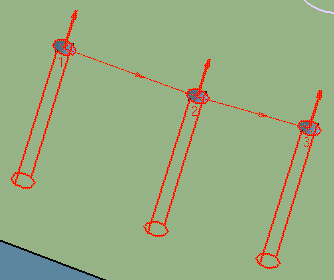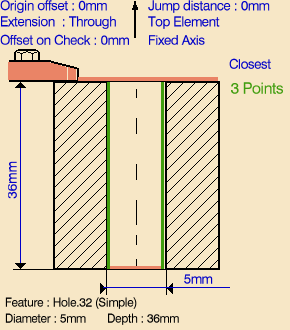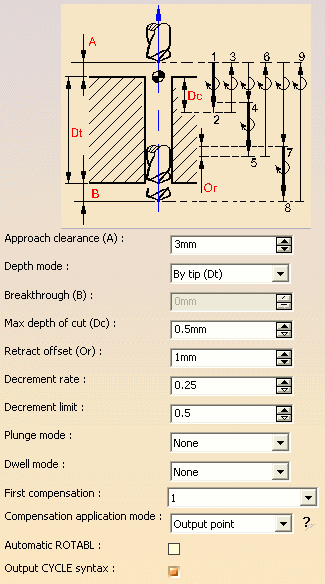|
|
This task shows how to insert a
Drilling Deep Hole operation in the program.
To create the operation you must define:
|
||
|
|
Open the
HoleMakingOperations.CATPart document, then select the desired
Machining workbench from the Start menu.
Make the Manufacturing Program current in the specification tree. |
||
|
|
1. |
Select Drilling Deep Hole
A Drilling Deep Hole entity along with a default tool is added to the program. The Drilling Deep Hole dialog box appears directly at the
Geometry tab page
|
|
| 2. |
Select the red hole depth representation then select the hole features as
shown below. Just double click to end your selections. |
||
 The sensitive icon is updated with the following information:
|
 |
||
| 3. | If needed, you can invert the tool axis direction by selecting the axis representation in the sensitive icon. | ||
| 4. | Select the
Strategy tab page
The other parameters are optional in this case. |
 |
|
|
|
A tool is proposed
by default when you want to create a machining operation.
If the proposed tool is not suitable, just select the
Tool tab page
Remember that you can make use of the hole diameter found on the selected hole feature to select an appropriate tool. This is described in Edit the Tool of an Operation. |
||
| 5. | Select the
Feeds and Speeds tab page
|
||
|
|
Note that in the
tool path represented in the strategy page, tool motion is as follows:
Distance (1,2) = A + Dc Also note that: For more information see Example of Decrement rate and Decrement limit. |
||
| 6. |
If you want to specify approach and retract
motion for the operation, select the Macros tab page
|
||
| 7. | Before accepting the operation, check its validity by replaying the tool path. | ||
| 8. | Click OK to create the operation. | ||
|
|
Example of
output If your PP table is customized with the following statement for Drilling Deep Hole operations:
A typical NC data output is as follows:
You can use Edit Cycle
The parameters available for PP word syntaxes for this type of operation are described in the NC_DEEPHOLE section of the Manufacturing Infrastructure User's Guide. |
||
|
|
|||